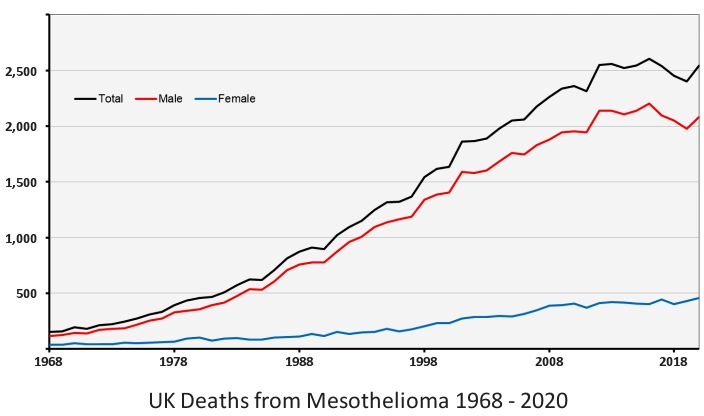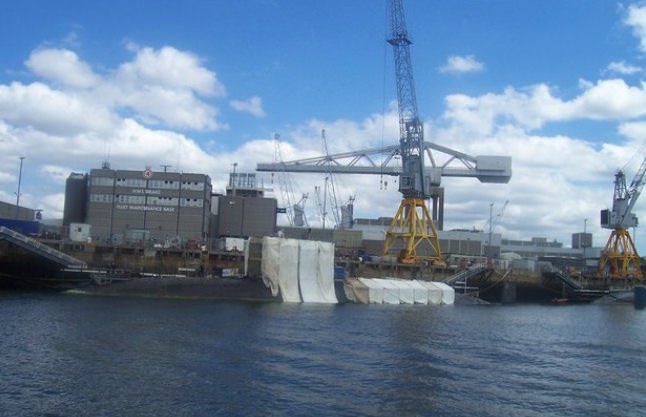HSE Mesothelioma statistics for Great Britain 2022
By Warren Miller. 3rd August 2022
Mesothelioma is a cancer that develops many years after the inhalation of asbestos fibres. Current evidence suggests that around 85% of all male mesothelioma patients were exposed to asbestos at work.
The remainder of male deaths and most female deaths were probably caused by asbestos exposure not attributable to the direct handling of asbestos. The latency period of 30+ years indicates that most mesothelioma deaths occurring today are a result of asbestos exposure during the period from 1950 to 1980.
Scale of mesothelioma deaths including trends
The chart below shows annual numbers of mesothelioma deaths in Great Britain from 1968 to 2020. There are many more male deaths than female - a reflection of asbestos exposure that occurred in the male dominated work-place.

Death from mesothelioma increased year-on-year for the last 50 years, with just over 8 times the number of deaths in 2011-20, compared with 1971-80. There were 2,544 deaths in 2020, an increase of 6% from 2019 when there were 2404 mesothelioma deaths, but close to the annual average number of 2523 over the period 2012-2019.
In 2020, there were 2,085 male deaths - similar to the annual average number of 2,107 for males over the period 2012-2019. There were 459 female deaths in 2020, a rise of 7% compared with 2019 and higher than the average of 416 deaths per year over the previous 8 years.
The coronavirus pandemic may have affected the number of recent deaths. In 2020, 63 of the 2,085 male deaths and 15 of the 459 female deaths had coronavirus and mesothelioma on the death certificate. Also, the number of deaths from mesothelioma may been lower had some of these deaths occurred after 2020 in the absence of the pandemic.
Mesothelioma deaths by age groups
The pattern of age-specific death rates is a reflection of both disease latency and the timing of past exposure to asbestos. Mesothelioma death rates are higher in older age because the disease takes many years to develop. The rates in men over 70 reflects the fact the amount of asbestos exposure in younger working life during the period of peak asbestos use during the 50s, 60s and 70s.
There have been falling Mesothelioma death rates in the under 65s for some time. This generation started working life during the 1970s or later when limits were placed on the use of asbestos in the work place. There are similar patterns in female deaths, though with greater year-on-year fluctuations due to the smaller numbers of deaths.
Industrial Injuries Disablement Benefit (IIDB) cases
Mesothelioma is a disease you can claim compensation for within the Industrial Injuries Disablement Benefit scheme which provides no-fault state compensation to employed earners for occupational diseases. For mesothelioma claims, this is often seen as the fund of last resort for victims of the disease who are unable to claim compensation from the insurance companies of previous employers. It aso provides an interim payment for claimants while the case progresses.
Please contact us for advice on whether you may have a claim by calling us on FreePhone 0800 923 0046.
Mesothelioma cases assessed for Industrial Injuries Disablement Benefit have increased over the last few decades with over 2000 cases per year currently compared with less than 500 per year during the 1980s. There were 1,910 cases in 2020 of which 280 were female, compared with 2,025 in 2019, of which 240 were female.
The reason IIDB cases are lower than annual deaths is that not everyone diagnosed with mesothelioma is eligible to claim and many may not be aware that they can claim. Annual IIDB cases have increased more rapidly than deaths during the period 2000-2015, probably because the Department of Work and Pensions (DWP) has increased awareness of the scheme. Also disease such as mesothelioma which have a poor prognosis are now fast-track for assessment.
The Covid 19 pandemic has led to a reduction in the number of IIDB assessments carried out in 2020 for many diseases. However the figures for mesothelioma and asbestos-related lung cancer have been prioritised within the scheme and automatically assessed at 100% disablement given the severity and poor prognosis of these conditions.
Mesothelioma deaths by region
Mesothelioma death rates in Great Britain have followed an upward trend over time, plateauing in recent years. For males this upward trend for all regions was evident over the long-term until around year 2010. Rates have fallen slightly in more recent years in most regions. Male rates in Wales are now similar to those in Scotland, with higher rates in England.
Rates are standardised according to the age-structure of the Great Britain population in 2018-2020 in order to allow comparison over time and by region. The numbers of cases is smaller for females, so the pattern in the rates over time is more erratic, but an upward trend is clear in all regions.
Mesothelioma deaths by occupation
Some occupations are recorded more frequently than expected on death certificates of men dying from mesothelioma. These are jobs associated with the construction industry such as carpenters, plumbers and electricians. Other occupations associated with the shipbuilding industry are still recorded more frequently than expected even though it is now many years since the exposure to asbestos took place.

An epidemiological study of mesothelioma in Great Britain confirmed high rates of disease among former building workers. The study suggested that about 46% of male mesothelioma victims born in the 1940s would be attributed to such exposure, with 17% attributed to carpentry work alone.
A factor in causing the higher risks appears to be the extensive use of insulation boards containing brown asbestos (amosite) within buildings for fire protection purposes.
The analysis of mesothelioma deaths in females is more difficult to interpret due to the lower proportion caused directly by occupational asbestos exposures. Occupations are recorded on death certificates as a matter of course (for deaths below age 75), and so inevitably there are various occupations that are recorded in appreciable numbers on female mesothelioma death certificates. However, not all of the deaths are attributable to asbestos exposures during the course of work in those occupations.
Deaths occurring from 2011 to 2020 mostly relate to people who were younger during the period of peak asbestos use in the 1960s and 1970s when the was less control on the use of asbestos, leading to a greater level of exposure. There is also new analysis showing that there is some variation in the average risk of mesothelioma among those who worked in jobs not involving the use of asbestos. For example, mortality ratios are higher for teachers and administrative occupations than those for nurses, sales occupations and process operatives. This suggests the potential for asbestos exposure during work time was somewhat higher in these jobs during the period of peak use.
The results of the British mesothelioma case-control study are consistent with the occupational analyses of mesothelioma deaths. The study suggested that only around a third of female mesothelioma deaths were a result of either occupational or domestic exposures, such as the risk associated with living with an asbestos-exposed husband. This suggests an increased risk among those who did not work with asbestos but who lived through the period of peak asbestos use. This background risk may account for deaths with occupations not typically associated with asbestos exposure recorded on the death certificate.
Estimation of future mesothelioma deaths
Mesothelioma deaths among males in 2020 is in-line with the prediction that a decline would start to become evident at this point and continue during the 2020s. Annual female deaths are expected to continue at the current level of 400-500 deaths per year during the 2020s before starting to decline.
The statistical projection model describes the expected the number of Mesothelioma deaths in the future as a smooth curve. However, the actual numbers of deaths each year may fluctuate due to random variation. Although the number of deaths increased in 2020 compared with 2019, the figure is nevertheless consistent with the statistical projection.
The statistical model used for these projections provides a reasonable basis for making relatively short-term predictions of mesothelioma deaths in Great Britain. In particular, when the declines in annual deaths were expected to start to be seen. However, long-term projections beyond 2030 are dependent on assumptions about certain model parameters for which there is no strong empirical basis – and in particular the extent of population asbestos exposure beyond the 1980s.

Source
Mesothelioma mortality by occupation statistics in Great Britain, 2022
https://www.hse.gov.uk/statistics/causdis/mesothelioma/mesothelioma-mortality-by-occupation.pdf
Author
Warren Miller MSc. BSc
Claims manager and website author
Warren has been assisting victims of Mesothelioma and asbestos cancer for more than 18 years. He is also the senior technical author of this website, responsible for sourcing legal and medical material beneficial to those who may been recently diagnosed with an asbestos disease.. Read more >













